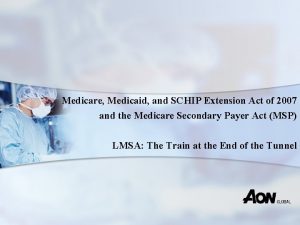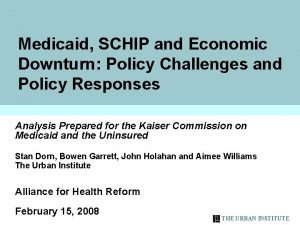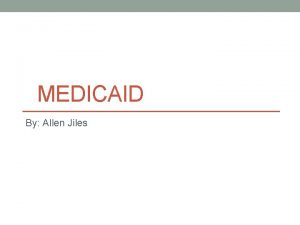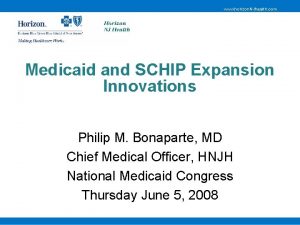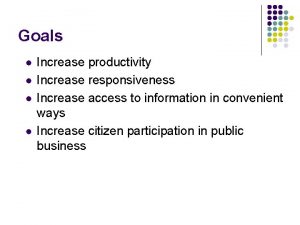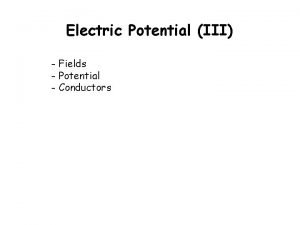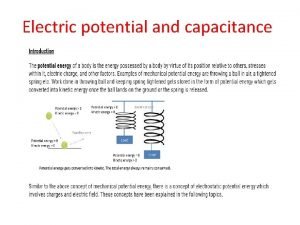Potential of Medicaid and SCHIP Expansions To Increase














- Slides: 14

Potential of Medicaid and SCHIP Expansions To Increase Insurance Coverage for CSHCN Amy Davidoff, Ph. D. Alshadye Yemane, B. A. The Urban Institute American Public Health Association Annual Meeting San Francisco, November 2003 Funding provided by a grant from the Maternal and Child Health Bureau

Background § Public insurance plays key role for CSHCN • Special eligibility mechanisms for disabled children, medically needy • Broad scope of benefits highly desirable • Higher public coverage rates overall § SCHIP expansions - key for low income uninsured § Little known about differential eligibility, participation patterns for CSHCN • Unique characteristics may affect eligibility • Participation patterns may differ • Program features, e. g. crowd-out provisions expected to be particularly strong deterrent

Background (cont) Family Opportunity Act (S. 321) § Permits public insurance buy in for severely disabled children § Various program designs • Expansions to 250% vs. 300% FPL • Medicaid vs. SCHIP buy-in

Research Objectives § Describe patterns of Medicaid, SCHIP eligibility for CSHCN § Examine participation patterns for CSHCN § Simulate eligibility & participation under FOA proposals

Sources of Data § National Health Interview Survey (NHIS) • Household survey • Non-institutionalized civilian population in U. S. • Pooled data from 2000 and 2001 § Federal and state Medicaid and SCHIP eligibility rules

Identifying CSHCN § MCHB Definition of CSHCN § NHIS elements replicate CSHCN Screener (Bethell et al. 2002). Captures children who have: • • • Regular need/use for prescription drugs; Elevated need/use of services Need/use special therapies (RT, OT, PT) Limitations in normal activities Emotional, behavioral or developmental condition that requires counseling or therapy § Consequences associated with health condition lasting or expected to last 12 months § 12 % of children identified as CSHCN on NHIS

Identifying Medicaid & SCHIP eligibles Algorithm replicates eligibility determination process § Determine monthly earnings, relevant expenses for disregards • Calculate “countable” income § Determine eligibility for Medicaid or SCHIP • Determine categorical eligibility • Compare federal & state specific income thresholds to countable income § Simulate FOA eligibility assuming existing rules, new income thresholds

Methods § Descriptive comparison of eligibility, participation for CSHCN, other children § Multivariate linear probability models estimate effects of child, parent, program characteristics on participation • Separate models for CSHCN, other children • Regression coefficients used to simulate participation under FOA expansions

Patterns of Public Insurance Eligibility

Waiting Periods, Premiums – Likely Barriers? § 19 % all eligible, 72 % SCHIP eligible CSHCN face waiting periods § Among SCHIP eligible CSHCN with waiting period • 27 % publicly insured • 10 % uninsured > waiting period • 60 % with private insurance § Among uninsured SCHIP eligible CSHCN • 80 % faced waiting period • ¾ uninsured longer than waiting period § 20 % eligible CSHCN have premium requirements

Public insurance participation rates higher for eligible CSHCN

Participation in Family Opportunity Act expansions depends on program design

Discussion § SCHIP expanded public insurance eligibility to large group of CSHCN • SCHIP expansions affected fewer CSHCN, allowed other children to catch up • Few uninsured remain ineligible • Policy focus on enrollment, retention § Participation generally higher among CSHCN but • few significant structural differences in participation behavior • difference in participation due partly to different characteristics of eligible CSHCN

Discussion (continued) § Participation rates generally lower for SCHIP programs. May be related to • Program characteristics: waiting periods, benefits, managed care provisions • More recent implementation • Characteristics of eligible children • Need further research on role of program design & implementation § Family Opportunity Act could additional eligible CSHCN • Participation rates depend on program design
 Medicare set aside flow chart
Medicare set aside flow chart Lesson 9 decimal expansions of fractions
Lesson 9 decimal expansions of fractions Half range series
Half range series Force x distance
Force x distance Stretching objects
Stretching objects Types of graded potentials
Types of graded potentials Define electric potential and potential difference.
Define electric potential and potential difference. Electric potential energy and potential difference
Electric potential energy and potential difference Water potential and osmotic potential
Water potential and osmotic potential Difference between sales potential and market potential
Difference between sales potential and market potential Electric potential inside non conducting sphere
Electric potential inside non conducting sphere Electric potential due to a dipole
Electric potential due to a dipole Electric potential and potential energy
Electric potential and potential energy Electrical potential
Electrical potential Flaccid cell
Flaccid cell
